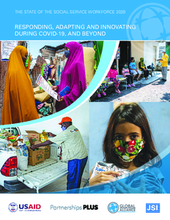The COVID-19 pandemic has placed great strain on the social service workforce. The virus and the measures adopted to contain it have required social service organizations and workers to reorganize the way they operate to ensure the health and well-being of the communities they serve.
Since the pandemic began, social service organizations throughout the world have shifted how they supervise and train their workers. In many countries, they have moved primarily to remote methods for delivery of services and supervision of staff. They have also devised means of dealing with increased levels of occupational stress and burnout resulting from a range of challenges, including workers’ increased caseloads and increased complexity of cases, workers’ fears of being infected with the virus or passing it on to a loved one, and, in some cases, workers’ feelings of inadequacy in their ability to meet their clients’ wideranging and evolving needs. In many countries, the social service workforce has needed to advocate with governments to be recognized as an essential service, and to obtain personal protective equipment to enable them to continue in-person services when necessary.
In most countries worldwide, social service workers have served at the frontline during the pandemic, adapting and innovating what type of services they offer and how. They have learned how to make best use of technology to provide remote counselling and support and, in doing so, have developed new ways to facilitate connections and build trust. In other contexts, they have risked their own safety to reach high-risk clients in-person, sometimes without access to personal protective equipment.
Drawing from a review of global reports and case studies, as well as from information sourced from Global Social Service Workforce Alliance members, this report explores the key challenges social service organizations and workers have faced since the beginning of the pandemic and showcases how they have been able to adapt and innovate in response to such challenges. It further considers the wide-ranging health, social, psychological, and economic impacts and magnified structural inequalities that have resulted from the pandemic and it explores the lasting impact of the pandemic on organizations and workers and the way they work, including their future needs, their changing roles and the opportunities they now have to further innovate and raise awareness of their work. It concludes with recommendations for how to build on these adaptations and innovations in practice and strengthen advocacy for further reinforcing the essential roles of the workforce. The aim of these recommendations is to help ensure the workforce is better able to respond and adjust, not only to this, but to future pandemics and global crises, and to tackle the complex social problems and deepening social inequalities that result.

